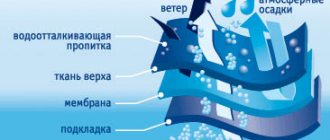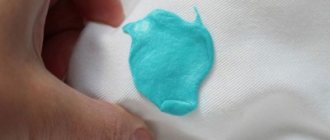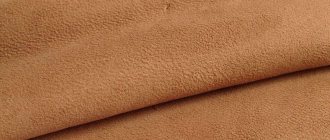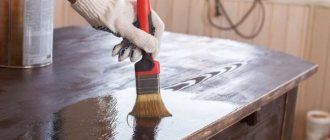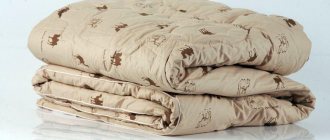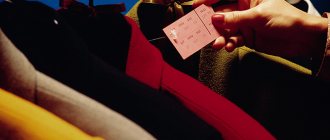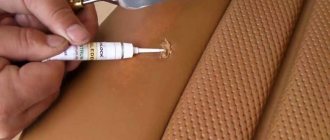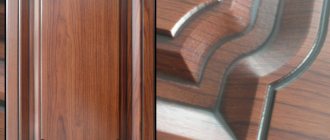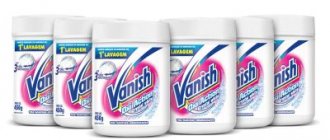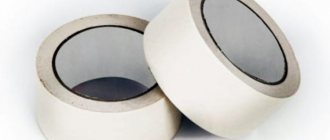History of creation
Spandex was developed by an American chemist, so the United States is rightfully considered its homeland. The fabric originated in the mid-50s of the last century. Elastane was born thanks to an accident. Textile workers tried to find an alternative to rubber. As a result of several experiments, such a fabric as spandex was born.
Large selection of colors
What kind of fabric is spandex? The name is derived from an anagram of the English word, translated meaning “to stretch.” This word perfectly reflects the essence of threads.
Product made of material
In Russia, elastane fabrics, as the fabric was called in Europe, appeared in 1975. It began to be actively produced and put into use. It is still used to create clothing and accessories.
Elastane fabric
Application
Due to its rather limited capabilities, spandex material is used for sewing clothes and a little in decoration. It is indispensable where a tight fit and full coverage is required. In addition, furniture is upholstered with spandex material; toys, covers, and cases are made from it. Since shoes that fit the ankle like a stocking are popular, they are also made from 5% spandex fabric.
They sew from spandex:
- sportswear for all sports, including gymnastics, diving, swimming;
- beach suits;
- medical, as well as everyday hosiery;
- all types of lingerie, including erotic and therapeutic;
- stage costumes;
- jeans and denim products;
- items made from eco-leather and eco-fur;
- thermal underwear;
- outerwear.
spandex shirt
spandex skirt
spandex dress
spandex tights
Spandex (elastane) threads, sold separately in spools, are added to the yarn when hand knitting.
A very insignificant and unnoticeable addition transforms the products: hats and socks do not stretch, sweaters do not have elbows, and knitted suits, fashionable in recent seasons, retain their shape, no matter what.
In recent years, spandex has been used in 3D printing to make elastic parts, mainly for medical purposes.
What kind of material is spandex: composition and properties
The fabric is obtained by melting the original raw materials. This matter is a polymer that is of artificial, that is, synthetic origin, because most of the composition, over 80%, is represented by polyurethane.
Note! The material is very popular due to a number of its advantages, including wear resistance, strength and availability. A high level of ductility allows the fabric to stretch in several directions. Based on this feature, there are two types of fabrics: two-dimensional and four-dimensional spandex. The first option implies the possibility of stretching in one direction, and the second - in two directions.
Strength and durability of the fabric
In addition, there is spandex, which can consist of natural components. Natural fibers, which can be cotton or linen, can increase the lifespan of the fabric.
Casual wear
Sewing features
The textile industry uses special equipment that helps to apply embroidery even on thin fabric. At home, it is important to follow these rules:
- The future seam should be marked with a special pencil or chalk in the areas of further stitching, because noticeable marks may remain from the pin.
- You should choose a needle for a special purpose: for knitwear or stretch fabric.
- For stitching, it is better to take an elastic thread, the skills of working with which also need to be worked out.
- Pre-test the seam on a piece to know how the product will behave. It is necessary to select the optimal stitch length to avoid further disappointments when working with workpieces.
Combination with other materials
You can often find combinations of elastane with other natural and synthetic components. Due to the satin, linen, tulle, cotton or viscose in the composition, the material is endowed with many advantages.
Lycra
The material has different names. In North America it was called spandex, in Japan - neolan, and in Italy - vorin. The second popular name for the fabric is lycra. It is the spandex thread that is the basis for creating matter. The material is very plastic, so it easily sits on the skin, like a second shell. The fabric is not particularly shiny; it's more matte.
You might be interested in this. Detailed description of pleated fabric: using knitwear for skirts
Lycra
Polyester
The combination of polyester and spandex gives the fabric good breathability. In this case, in winter the clothes will help keep you warm, and in the summer they will be comfortable due to the passage of air through the fibers. One of the disadvantages is that light-colored products are easily exposed to sunlight. When exposed to ultraviolet light, the fabric fades and the white color turns yellow. When acetate is added to the pair, a high-tech combination is obtained that makes the fabric a more durable and wear-resistant material. Such fabrics are used for sewing jackets and outerwear.
Polyester
Linen
Adding flax to the composition turns products into more environmentally friendly and safe things. They retain all the properties of elastane and keep their shape well. The appearance remains beautiful even after numerous washes, and things do not wrinkle or shrink.
Linen
Viscose
Such man-made fibers are quite popular in combination with spandex. The result is a very soft, light, skin-friendly fabric that has significant density.
Viscose
Satin
Satin and elastane work perfectly in a duet. If outwardly 100% spandex looks cheap, then satin gives it that very zest. The result is very durable, soft, airy, high-quality products.
Satin
Nylon
Nylon fabric has a reliable level of durability, which is achieved due to its high density. Such products are able to remain in their original form for a long time and react poorly to aggressive influences.
Nylon
In addition, when adding elastane to denim, beautiful stretch synthetic items are obtained.
Spandex - what is it?
Technologists from the American company DuPont were in search of new developments of rubber analogues. During the tests, an innovative material was created, called spandex. Let's take a closer look at what kind of spandex fabric this is.
PHOTO: bitvasalonov.ru Fabric can safely be called spandex if it contains at least 2% polyurethane
Composition and characteristics
In order to better understand what kind of material spandex is, let’s take a closer look at the composition of the fabric. The fabric is practically not produced in its pure form, since it is more like rubber than a product of the textile industry. The material consists of polyurethane, the inclusion of which can reach 85%. Additional components are polymer compounds, for example, nylon and acetate.
Spandex fibers are also added to wool or cotton knitwear; they protect the fabric from stretching and give it elasticity. The addition of elastane is suitable for the manufacture of hosiery, as well as items intended for weight loss, since it produces a sauna effect.
PHOTO: stayer.su The fabric is produced by chemical processing of raw materials and its molding using a dry or wet method
Characteristics
Due to the basic property of matter to stretch and return to its original state, designers widely use fabric to sew body-fitting clothes. The canvas sits effectively on the figure, emphasizing all its advantages.
Buyers do not always know the name of the fabric that stretches like an elastic band. Depending on the stretchability of the fabric, spandex is divided into two main groups:
- two-dimensional fabric stretches only in length or width;
- Four-dimensional matter is pulled in all directions simultaneously.
PHOTO: tkanix.guruSpandex is ideal for making tight clothing
Advantages and disadvantages
Despite its artificial origin, spandex has a large number of positive properties:
- excellent elasticity, fibers stretch up to 8 times, and the finished product - 3-4 times;
- high hygroscopicity;
- durability;
- excellent strength up to 1.3 g/cm²;
- wear resistance;
- spandex does not wrinkle;
- the fabric is light in weight;
- the surface has a beautiful shine.
PHOTO: roomester.ru By the inclusion of satin in spandexa, you can determine what the shiny fabric is called
Unfortunately, manufacturers have not yet come up with the ideal material, so spandex also has disadvantages:
- matter is sensitive to light;
- spandex reacts to high temperatures;
- accumulates static electricity;
- has low thermoregulation;
- pellets may appear on the surface from frequent washing.
PHOTO: tkanix.guru Puffs may form on the surface
Scope of application
Initially, textile production was tasked with making fabric for military uniforms. As a result, spandex was born, which became applicable in a much wider range of areas of human activity. This fabric is widely used in the creation of everyday clothing for people. What is spandex in clothing? These are, of course, dresses, swimsuits, socks, shapewear, tracksuits. Linens are able to retain heat, so they are used in the manufacture of warming underwear.
On a note! Traditionally, it is used to make rocker clothes, stage outfits, superhero and clown costumes. It is also used to make furniture, curtains, drapes and medical gloves.
Military uniform
Care instructions
We have discussed what spandex is in clothing - it’s time to move on to care recommendations. It is the observance of simple rules that will help preserve the integrity of the item and its high quality for a long time!
First, let's talk about how to wash spandex:
- Can be washed by hand;
- You can also wash it in a washing machine on a gentle cycle, at a temperature not exceeding 40 degrees;
- Avoid using bleaching products;
- The use of bleach is prohibited;
- Do not turn on the spin at high speeds under any circumstances.
Let's move on to ironing and drying:
- Avoid machine drying - this will lead to loss of color and appearance;
- It is best to hang things (or lay them out) in a cool, dark place;
- Avoid direct sunlight;
- It is better to refuse ironing;
- If it is necessary to iron the product, set the minimum temperature and add gauze.
Here are a few more nuances:
- Should be stored in a dry, dark cabinet;
- Avoid dry cleaning.
There are no more unclear nuances left about what spandex material is, what kind of fabric it is and where it is used. Finally, detailed customer reviews await you! You can learn how to wash membrane clothes in a machine by following the link.
a
How to sew with spandex
You can sew wardrobe items from elastane not only using special equipment, but also with your own hands at home. The fabric is quite demanding, but if all conditions are met, the result of the work will definitely please you. It is best to start performing all manipulations on a small extra piece of fabric. This way you can not only verify your ability to make something from elastane, but also practice working with such material. Some tips:
- It is necessary to purchase special needles for working with knitwear, which are designed for knitting.
- Since the spandex material is inherently fragile, you should not use needles or pins. You should give preference to chalk or a non-sharp pencil.
- When sewing, the fabric should be slightly stretched, thus avoiding deformation. For spandex, elastic is suitable - thread.
You might be interested in Description of terylene: how such fabrics are obtained and used
Application area
Spandex has become an almost traditional material for the production of everyday clothing and rare types of garments: corsets, rocker trousers, superhero costumes and stage outfits for circus workers (mainly clowns).
Due to increased stretchability, furniture covers are also often made from this material.
Spandex wardrobe options:
- swimwear;
- sports items;
- dresses;
- slimming corrective underwear;
- socks and stockings;
- denim items.
Modern sports thermal underwear is also made of spandex, providing maximum contact with the body. The ability to allow air to pass through allows you to simultaneously get rid of excess heat and effectively remove moisture from the surface of clothing during perspiration.
However, in the absence of high mobility, heat-saving items are not recommended, since, unlike wool, they cannot accumulate heat for a long time (the fabric is not warm).
How to choose spandex fabric
The choice of material should be taken seriously and carefully. Poor quality fabric can have a negative impact on the process of creating or wearing the finished product.
Shirt
Important! Before purchasing, you should carefully consider the material. There should be no damage on it: holes, puffs and pellets. Also, the color should be uniform and without spots.
Description of elastane features:
- The first impression when touching spandex should be pleasant. The canvas should shine, be velvety and soft to the touch.
- Elastane should stretch well, increasing several times. Don’t be afraid to test fabric for ductility and strength.
- The best producers of the material are Europe, USA, Russia, Belarus and China. Which one to give preference to, everyone decides independently.
Features of care
Despite the unpretentiousness of the material, the products require some care:
- When cleaning, you should not give preference to strong, aggressive detergents. Do not use bleach under any circumstances. The washing temperature should not exceed 40 degrees.
- It is not recommended to iron the fabric. Spandex is characterized by its ability not to create wrinkles. Some people still start ironing and steaming their clothes by mistake. If the composition contains natural fibers, then this process can be resorted to, but with caution. It is best to use gauze as a lining and thus not allow the iron to come into contact with clothing. The iron temperature should not be higher than 150 degrees.
- Since matter is afraid of the sun, it is better to store it in a dark, dry place. And if you need to transport it, you need to close it tightly in a box, bag or suitcase.
- Dryers are not the best option for spandex. Air drying should only be done on non-sunny days or in places protected from light.
Spandex
Does spandex stretch or not?
As noted above, the material is capable of elongating to incredible sizes . It is capable of stretching the fabric it contains, sometimes 2-3 times. In its pure form, spandex can increase in size by 7-8 times. In this case, there is a two-dimensional canvas (it stretches in length and width) and four-dimensional (elastic in all directions).
Advantages and disadvantages
Advantages:
- Elasticity. The material has a high level of ductility, so it stretches well. When stretched, the dimensions can increase up to 7 times.
- High degree of wear resistance. Products made from spandex can serve their owners for many years.
- Ease. The material has virtually no weight, so it is comfortable and easy to use.
- Products are not subject to shrinkage. After many washes, the fabric retains its original appearance. But of course, it all depends on the washing method. If done incorrectly, the material may change by a factor of 2.
- Softness. The material is very pleasant to the touch. Due to this, tactile contact between the skin and clothing brings pleasure and allows you to avoid discomfort and unpleasant sensations while wearing.
- Hygroscopicity. Due to their high level of density, the fabrics repel water droplets, keeping clothes dry.
- The material is resistant to contamination. Even the most dangerous dyes for clothing: wine, juice, cosmetics, nail and hair varnishes are not capable of ruining the item forever. It is easy to clean from stains.
- At the same time, during the creation process, clothes can be dyed. It easily takes on the desired color, so it can have a huge palette of shades.
- Elastin does not wrinkle at all. Due to the absence of the possibility of wrinkles, products made from such fabric do not need to be ironed, which saves time.
- The fabric is smooth and shiny, which makes a pleasant visual impression.
You might be interested in what are the features of pleated mosquito nets
Flaws:
- The fabric is easily deformed. If you try to fix a hole manually, the material may behave poorly. And the reason for this is the special method of weaving threads that is used to create matter. You should not pin pins, brooches or badges to your clothes.
- The material is not protected from ultraviolet rays. If exposed to the sun for a long time, yellow spots may appear on the fabric.
- Spandex is a man-made material. It can cause allergic reactions in people, so the fabric, which is 100% elastane, is not recommended for allergy sufferers.
Some reviews
When purchasing this or that item, most people are guided by the opinions of those who have already purchased and evaluated a similar purchase for themselves. There are many forums and blogs on the Internet aimed at making an informed choice of a certain thing. Here are some of the reviews about fabrics containing elastane (spandex):
- The combination of viscose and elastane has a high degree of wrinkleability.
- Cotton and elastane are the perfect combination for a durable and practical item.
- Cool knitwear with the addition of lycra is an excellent analogue of cotton fabric: it does not wrinkle and does not require ironing, and at the same time retains its shape for a long time. Even more information about combining a cooler with Lycra can be found in this article.
- The diving fabric is composed of polyester, lycra and viscose and is best suited for various sports equipment. The fabric perfectly absorbs moisture, fits the figure, and does not hinder movement. The disadvantage is the low breathability of such products.
- Footer fabric with lycra is another option for the composition of cotton, which looks like knitwear with polyurethane fibers. Also suitable for sewing tracksuits (especially insulated models), and is also ideal for household items.
Reviews
Marina, Tyumen: “I recently made myself a spandex suit, it looks just great, I chose the color coffee with milk. The quality of the fabric is very good, it holds the shape of the product, it seems to be a little stretchy, and the sheen of it is like velvet, I am very pleased. Moreover, I found out that spandex also comes in different densities, suitable even for a bandage, so I’m thinking about getting a thinner one for a dress, the colors of the fabric are very diverse.”
Irina, Anapa: “I liked the dress made of this material, I bought myself a black, tight-fitting one, it even sparkled a little in certain lighting. The only thing that caused discomfort was that it constantly needed to be corrected, otherwise it would rise to the top.”
Lyudmila, Kerch: “A friend recommended this fabric to me. I was satisfied and very glad that I listened to her advice. I sewed a custom evening dress for a special event. The dress did not hinder my movement and hugged my body very effectively. And the best part is, of course, the price of this fabric.”
Most buyers vote for spandex due to its ability to not restrict movement. It is comfortable to move and exercise in such clothes.
Application of spandex
Elastane is used in the textile industry to improve the characteristics of finished fabrics. It is used in furniture production for upholstery of soft furnishings and sofas. Fabrics become the basis of stage looks, the most famous of which are the costumes of Power Rangers, Spider-Man, leggings, which were actively worn by musicians of the eighties, metal performers, and modern glam performers. In the production of medical and work gloves, adding elastane to the cuffs prevents the protective elements of clothing from falling off.
- Treatment of prostate adenoma - drugs and folk remedies. How to treat prostate adenoma in men
- Crochet patterns - simple patterns for beginners
- Scallop: recipes
Spandex clothing
Elastane is used to sew clothes that will fit tightly to the figure. Making clothes from this material is relevant in the following cases:
- For the manufacture of swimwear, elastane has a high degree of hygroscopicity.
- Spandex material is used to create sportswear due to the fact that stretchy items do not hinder movement.
- Adding just 5% neolan to denim helps produce tight-fitting styles.
- It is used for sewing stockings, underwear and slips, because the thin stretch perfectly emphasizes the figure.
Fabrics with added spandex
Cotton is a natural fiber that allows the skin to breathe, but it does shrink, and the addition of elastane solves this issue. Spandex is also used in combination with other fibers:
- Linen with high hygienic properties does not stretch at all, and the quality of the finished products is affected by loss of shape. Lycra increases the elasticity of the fabric.
- Adding spandex to rayon adds strength that it lacks.
- Products made from knitwear with the addition of lycra retain their shape longer.
- Diving fabric, which includes spandex, is used for sewing sports and circus outfits, as such clothing stretches and absorbs moisture well.
- The combination of polyester, cotton and viscose is called micro-oil. This fabric does not wrinkle, it remains soft and light.
Spandex thread in knitwear
In the description of yarn you can often see the addition of elastane or lycra. This helps finished products retain their shape, and the material can be used to create any product, even knitted swimsuits. It is easier to work with threads of this composition due to slip. The addition of elastane significantly reduces the price of natural yarn due to its low cost.

